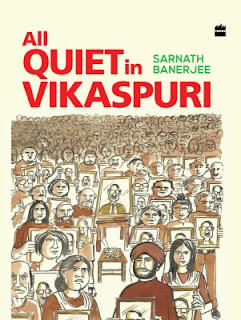 Sarnath Banerjee has put out a graphic novel this year of the Lord, 2016.
Sarnath Banerjee has put out a graphic novel this year of the Lord, 2016.It's called All Quiet in Vikaspuri. It concerns the water shortages of New Delhi, a quest to discover the mythical Saraswati river, and is populated by a whole range of usual suspect signature odd-ball characters with the most random of obsessions.
These characters are weird not because Banerjee has displayed a warped imagination in their creation. They are uncannily like people we call our relatives, parent's friends, neighbours, or meet when we have some dealings with the Government of India.
Banerjee's genius is to release the character from their arranged marriage prison of domesticity/employment and unleash them into full-action sequences.
This includes: a shooting war where a Sintex tank has been armoured into a war tank; a mustachioed army-man retiring to activism in the timber forests of Burma; or a MBA-type sketching uniform designs to fill the after-hours subsequent to earning the Gurgaon consultancy services millions.
Every Indian stars in his own Bollywood film. Banerjee has just imagined what the posters should be.
It is kick-ass, paisa-vasool, and vintage Banerjee. Additionally, this being his fourth album, there is a new dimension to it.
What this dimension is requires further explication. However, be warned, we will need to examine the whole nature of capitalism, media, the history of mark-marking texture and print-technology to understand how Banerjee's work has evolved from the halcyon days of Corridor (2004).
Banerjee is often mistakenly called the grandfather of the graphic novel in India. That honour falls to someone else.
No, not Pran. Pran lived in Chandigarh and he did comics.
Only a Bengali can make a comic into a graphic novel. That is until Amruta Patil and Samhita Arni came around but why quibble? Comics are not the ancestral property of anyone.
No, by grand-pappy of comics, we mean Orijit Sen's River of Stories (1994).
Sen's graphic design work (which includes the poster of Rohith Vemula floating in space that protestors use apart from vicious cartoons) has now reached the apex that any Bengali artist can aspire to: huge blow-ups of his work grace a fine biryani and kebab restaurant in Park Circus, Calcutta. After that honour, it's the slow inexorable drift to death.
C.L.R James, after whom they named the Hackey Archives and Library in Dalston, London, noted after seeing a Ford factory in American Civilisation:
So, what distinguishes a fine artist from an illustrator?
During the last thirty years, mass production has created a vast populance, literate, technically trained, conscious of itself and of its inherent right to enjoy all possibilities of the society to the extent of its means. No such social force has existed in any society with such ideas and aspirations since the citizens of Athens and the farmers around trooped into the city to see the plays of Euripides, Sophocles, and Aeschylus and decides on the prize-winners by their votes. The modern populace decides not by votes but by the tickets it buys and the money it pays. The result has been a new extension of aesthetic premises.
A fine artist makes his living selling unique pieces of work to the insanely rich.
An illustrator's work, on the other hand, is for mass production. The public votes on whether the artist gets to eat or not.
Comics, originally, were the lowest of the low when it came to pulp. In fact, in the 1950s, they were used as ballast for American navy ships. When the ballast was off-loaded at ports in Britain, the urchins picked them up. In response, the UK did what it does best-- the country had a moral panic melt-down and banned comics altogether.
Nowadays, original comics artworks are being auctioned by Sotheby's but these are mostly of dead people.
Mr. Banerjee is awesome in that he has managed to straddle both worlds in his youth. His work is collected as well as mass produced. He deserves the Bharat Ratna on this point alone.
With this album, however, it seems that Mr. Banerjee is re-discovering his love for comics as comics, and not as fine art. Additionally, the artist shows a subtle mastery in the use of tonal inks to provide texture and shadow in his work that will please collectors.
You can either read Rana Dasgupta's Capital or get a sense of Delhi's weirdness and dysfunction in a fraction of the time with this album.
Comments
Post a Comment